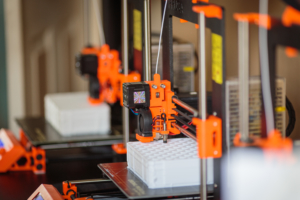In this installment of our series, we are looking at the Singapore 3D printing ecosystem. By giving you an overview of some of the 3D printing startups in Singapore, we hope to show you just how vibrant 3D printing life of the city state is.
Siege Advanced Manufacturing
Siege Advanced Manufacturing is a 3D printing service that uses low-cost systems to serve customers. I love the “low-cost service bureau” model, where Creality, Flashforge, and Anet 3D printers take on industrial systems head on. Going forward, as low-cost systems improve these kinds of services using print farms of desktop systems will be much more competitive.
At the moment, the reliability, repeatability, accuracy, and uptime of these systems is significantly lower than that of industrial systems. But, every year the gap closes slightly. And, with a number of flexible systems using lower cost materials, scrap is cheap. I really believe that we’ll be seeing a wave of low-cost services emerging in the near future.
It will be interesting to see what printers these firms turn to. Some are going with Anet and similar systems, while others user higher end Ultimaker machines. Siege has opted for the Prusa Research i3 MK2S, which would be my choice as well for this application. It offers a hell of a lot of value for $800 and is very well built. To me, this is the Goldilocks printer for print farms, due to the balance between affordability and reliability.

Siege has made over 200,000 parts and currently has 18 Prusas. So, I’m thinking the ROI is okay on the printers. Also, how incredibly low is that as an initial investment in a print service? So, on the one hand, Siege will be performing incredibly well as a traditional business. It really shows us that there are opportunities that exist in print farms that are relatively accessible. And, here, of course, we come to a bit of a problem when considering it as a startup. Where is its moat? How can they fight off competition? This, of course, will be very difficult. If it automates file handling, makes its own filament, and maintains some form of improved automated part handling, the company can have an edge, but, without those three elements, it could be difficult for the firm to endure.
Ringtheory
Ringtheory is a company that makes 3D printed wearables. They have a ring that can let you board and pay for the metro in Massachusetts, for example.
It’s a wonderful idea and, with access cards, chip payments, electronic payments, Square, Alipay and more spreading globally, one would expect a personalized series of jewelry items to do well. Something mass customized, personalized, or fun that can help you board the train or go to the office sounds like it could appeal to many. The startup got going in 2017 and received press and partnerships, but it seems moribund now. Rings are shown as out of stock, which, of course, if they’re 3D printed is kind of hard to understand, and the site doesn’t seem to be getting updated. I hope that this startup will continue or that someone can buy it to take it forward because it seems like a promising idea.

AuMed
AuMed makes medical models, AR simulations, training aids, and more for medical professionals. The team use DICOM files to model parts based on rare pathologies and have models for sale in their web shop. You can also come to them for training solutions and medical models.
I like the firm’s transparency and directness and they seem to be very experienced in what they do. They have mannikins for COVID swab training, heart simulators with tactile feedback, and adult ear models to teach how to repair a hole. Altogether, AuMed offers very useful services that saves medical costs worldwide. Moreover medical models can be used to educate patients, allowing them to understand medical choices better and aid in classroom instruction, as well as surgical planning. So far, a string of firms similar to AuMed has worked locally across the globe. 3D Systems acquired the biggest one years ago, but there has been little consolidation in this space. It is ripe for one company to become the default medical model provider worldwide, will it be AuMed?
Subscribe to Our Email Newsletter
Stay up-to-date on all the latest news from the 3D printing industry and receive information and offers from third party vendors.
You May Also Like
Gorilla Sports GE’s First 3D Printed Titanium Cast
How do you help a gorilla with a broken arm? Sounds like the start of a bad joke a zookeeper might tell, but it’s an actual dilemma recently faced by...
Nylon 3D Printed Parts Made More Functional with Coatings & Colors
Parts 3D printed from polyamide (PA, Nylon) 12 using powder bed fusion (PBF) are a mainstay in the additive manufacturing (AM) industry. While post-finishing processes have improved the porosity of...
$25M to Back Sintavia’s Largest Expansion of Metal 3D Printing Capacity Since 2019
Sintavia, the digital manufacturing company specializing in mission-critical parts for strategic sectors, announced a $25 million investment to increase its production capacity, the largest expansion to its operations since 2019....
Velo3D Initiates Public Offering in a Bid to Strengthen Financial Foundations and Drive Future Growth
Velo3D (NYSE: VLD) has been among a number of publicly traded 3D printing firms that have attempted to weather the current macroeconomic climate. After posting a challenging financial report for 2023,...





























